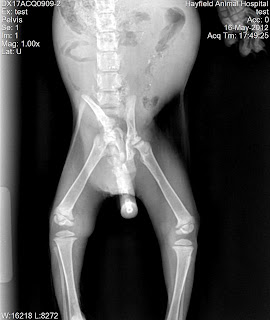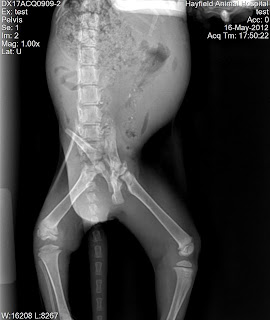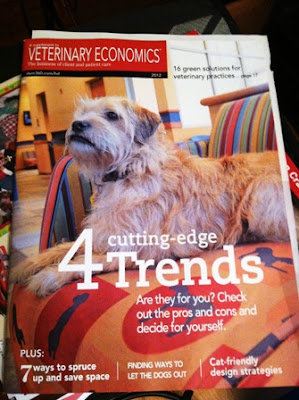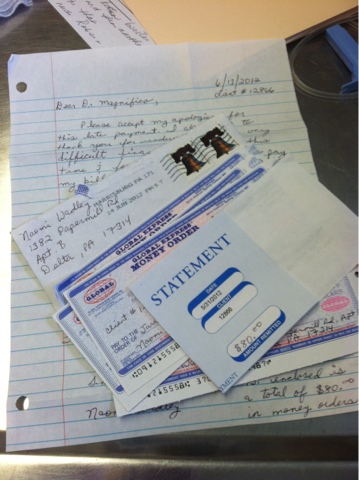I received a tweet from someone who found me on Twitter
asking “If I could, or knew of anyone who could, repair a fractured pelvis in a
found kitten?”
OK, this isn’t a request I get everyday (TG). I replied back
asking for more information.
Pelvic fractures, (like every other fracture) come in all sorts of sizes, shapes, and degrees of difficulty, and patient information is very important also. (Quick mention, almost every question I am asked is in dire need of significantly more information. I had a person call yesterday for an estimate on a dental? I needed a lot more information before I could give her the dollar figure she was in search of. Note to general public; don’t call for an estimate, make an appointment and go over every line item that the surgery requires. There is very rarely a “set price” for anything and every pet and every procedure should be individually customized and charged appropriately).
Pelvic fractures, (like every other fracture) come in all sorts of sizes, shapes, and degrees of difficulty, and patient information is very important also. (Quick mention, almost every question I am asked is in dire need of significantly more information. I had a person call yesterday for an estimate on a dental? I needed a lot more information before I could give her the dollar figure she was in search of. Note to general public; don’t call for an estimate, make an appointment and go over every line item that the surgery requires. There is very rarely a “set price” for anything and every pet and every procedure should be individually customized and charged appropriately).
After a few tweets back and forth, I learned that Jade was a
5 week old kitten who was found in the middle of a very busy highway. The people who
found her thought that she had “been thrown from a car.” She had been to a veterinarian
already and they had been told that Jade had a fractured pelvis
and would need a $3,000 surgery to fix it. The girls lacked the extra cash and decided to hit
the social media to find some help. (I’m still not sure how they found me, other
than Twitter, but I was 2 hours away, and not an expert on pelvic fractures. I
will take the inquiry for my services as flattery and leave it at that).
 |
| This is the highway Jade was found on. |
As a matter of course I had a whole slew of questions. The first
began with, “Who told you that she needed surgery?” I guessed it wasn’t a
surgeon because I don’t know any reputable surgeon who would tackle a pelvic
fracture in a 5 week old 1 pound kitten. I am also pretty sure that this feat is
physically impossible. There aren’t even bones in a 5 week old kitten. It’s all
just soft mushy stuff that eventually turns into bones. You cannot even find a
bone plate that is small enough. I was happy to help this kitten but most of
what I was hearing didn’t jive with reality.
I asked for the radiographs and told the girls that I would
review them and pass them along to my surgeon friends.
But my second question was really the only question that
mattered. “How is she doing?”
“Oh! She’s great! She is happy, playing, and eating.” Their
tone had changed to a neffervescent jubilant proud parent when they explained how
cute she was and how adorable every one of her kitten gesture’s was.
I reminded them that the patient dictates the treatment
plan. Not the blood work, x-rays, or opinions of an “expert.”
I asked about the physical exam findings from the veterinarian that Jade had already been to. All the girls could recall was x-rays, pelvic fractures, and surgery. Not much for me to base a decision on.
We agreed that the best plan was to bring Jade to me so I could
re-assess her and take more x-rays. It had been about 5 days since the first
x-rays and I wanted more views if I was going to try to send them to a surgeon. I also needed to know a
few key pieces of information. They included; her ability to ambulate, her
nerve function to both feet, and any additional signs of trauma. I also wanted
to be sure that she was disease free, (specifically FeLV/FIV). Everything hinged
on these questions.
A few days later Jades foster mom drove the 2 ½ hours north,
through both the DC and Balt beltways, for me to take a look at her.
As soon as I opened Jade’s carrier she leapt out and ran
around the exam room. She was a little black 1 pound bucking bronco! She didn’t
hesitate to investigate her surroundings, she just busted out like it was her
very own coming out party!
OK, I thought, I could immediately cross almost all of my items off of her "critical information" list. She
obviously had full motor function, full nerve function, full strength, and
after her mom verified her negative FeLV/FIV test, and that she was perfect in her ability to eat,
drink, urinate, and defecate. I discussed my treatment suggestions.
To summarize I said “She thinks that she is perfectly fine. Listen to her. Don’t decide based on x-rays. She is too little and too comfortable just the way she is to risk an almost impossible surgery. I don’t think that you could even find someone to perform her surgery. IF you do I want to talk to them. She absolutely needs to be spayed at 5 months old, because her pelvis will likely heal crooked, and she may not be able to pass kittens through a crooked pelvic canal. But I think you saved her life, and I think she is one very lucky miraculous kitten. And as the old saying goes “put a kitten with a thousand broken bones in a bag and 2 weeks later they will heal.” (OK, skip the bag part, but the old saying in essence is that kittens and their 9 lives are amazingly resilient creatures, so don’t give up on them without giving them a chance to amaze you).
Over the last few weeks I have gotten many updates on her
progress. Sure enough she is doing great and hasn’t skipped a beat!
I hope to see her in another few weeks for her spay. If I do
see her (I know it’s a long drive so I won't take it personally if they decline
to battle both beltways for me, although I will secretly beg and plead, and do
it for free!) I will take x-rays and see just how that mangled pelvis did
eventually heal.
Here is Jade’s Facebook page and information.
http://www.facebook.com/#!/HelpSaveJade
Thanks to her foster family and all of those who helped to save
her life. The compassion of mankind can be found in the most common of places
and I am happy to have played a part in her story. Best of luck to you all, and
give her a big kiss from me and the rest of us at JVC.
XXOO!

















































